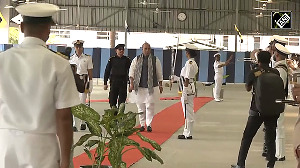When fierce storms hit California in early January, submerging streets and felling power lines, Steve Livingston was prepared. Armed with a text message alert from the San Mateo County Office of Emergency Services, he dodged the flood and made it home safely.
A few months earlier, when a surprise earthquake shook the region, Livingston, chief marketing officer of Sunnyvale, Calif.-based mobile transaction firm mBlox was in Los Angeles on a business trip. Alerted by a text message from the same service, he rushed to call his family back in Hillsborough, near San Mateo. "The pervasiveness of text messaging makes it one of the best ways to communicate to masses of people," he says.
In pictures:
Mobile phones that could save your life
10 wallet-friendly cell phones
Cellphones have long functioned as the front lines of emergency calling. As technology evolves and phones morph into ubiquitous, highly personal gadgets, they're becoming genuine safety devices, crammed with features designed to protect us from accidents and injury. Between flashlights, heart monitors, global positioning data and text message warnings, it's no exaggeration to say that cell phones can save lives.
Mobile alerts fit our increasingly wireless lifestyles. Americans send more than 48 billion messages each month, according to industry group CTIA-The Wireless Association. A consumer survey by software firm ACCESS and researcher Amplitude Research found that nearly 90 per cent of cellphone users believe mobiles are important for communicating during an emergency or a crisis.
Even the government is signing on. The Federal Communications Commission is developing a national mobile alert system for 2010. The messages, which will be distributed through the country's four largest carriers (AT&T, Verizon, Sprint Nextel and T-Mobile) will include "presidential" or national emergency alerts, weather and local emergency alerts and child abductions. In a statement, FCC commissioner Michael J. Copps praised the ability of mobile alerts to reach people who aren't near a TV set or radio or lack electricity.
In pictures:
Coolest future phones
What your mobile phone says about you
The move follows the FCC's attempt to establish a public safety communications network on radio spectrum auctioned earlier this year. Such a network would enable police and emergency workers across the country to seamlessly communicate on wireless devices. The FCC has said it hopes to establish such a network within the next few years.
In the meantime, companies and organizations are crafting their own mobile safety networks. Several phone makers, including Samsung and Asus, offer SOS functions that--with the push of a button--ping pre-set numbers with text messages that warn the sender is in danger.
In late April, community action group Crime Stoppers launched a program that allows people to submit crime tips to police via text message. The application is designed to appeal to text-loving teens and folks who spot something suspicious, such as drug dealing, gang activity and hate crimes while on the go, says Crime Stoppers USA president Elaine Cloyd.
In pictures:
Hottest celebrity mobile phones
Ten top touchscreens - and the iPhone
Troy Daniels, deputy chief of police in Champaign, Ill., says his local Crime Stoppers received two text tips on the day the service launched--one for a murder and one on a drug dealer. (Encryption keeps tipsters' cell numbers private.) The technology, which is supplied by Anderson Software and mBlox, is currently active in 32 cities in the US and 16 in Canada. Crime Stoppers is seeking grants and corporate sponsorships to expand it nationwide.
Mobile alerts--messages moving the other direction--are another way cellphones can save lives. Manhattan-based Send Word Now delivers millions of mobile alerts a year for corporate, academic and public sector clients including Wal-Mart, Boston University and the US Postal Service.
New York City is testing a Send Word Now program that combines emergency notifications with everyday warnings, such as traffic. Text alerts have been growing in popularity for the past two years, says chief executive officer Tony Schmitz. Reliability and speed are factors. Even when phone lines and cellular networks are clogged with traffic, text messages tend to get delivered, within minutes.
Of course, mobile devices carry their own risks, including distractions and loss of privacy, particularly with GPS. But advocates say that mobile safety functions are getting smarter and more specific. Send Word Now can program messages to be distributed automatically as soon as its software detects an event or disaster, speeding up the process and removing human error.
Some firms are attaching documents to text messages--perhaps a floor plan for evacuation or a list of emergency procedures for employees to follow. Others are asking recipients to respond to alerts, pressing 1 if they're OK, for instance, or to join a conference call after reading the message.
Wireless home security systems can send alerts to cellphones, warning of intruders. Callback software can be programmed to automatically dial a phone in set time increments. If the user doesn't answer, the system alerts authorities.
Phones can help in emergencies, even if you're injured or incapacitated. In the US, government-mandated "E911" services log the locations of cellphones that dial for help. If necessary, these systems can backtrack and trace callers. First responders such as firemen, paramedics and ER nurses automatically check cellphones for emergency contacts. Designating someone in your phone's address book as "ICE"--"In Case of Emergency"--is an easy way to ensure that the right person gets called in critical situations.
Some firms are going further, viewing phones as the 21st-century equivalent of medical ID bracelets. Marina Del Ray, Calif.-based developer MyRapidMD Corp. is one. Its Emergency Service Profile software application is designed to be installed on cellphones and relay basic information about its owner to first responders.
Users submit data including blood type, medications, allergies, emergency contacts and a photo for identification purposes. The information resides on their phones where it can be quickly and easily accessed, even in areas without cellular reception. If the phone is broken, emergency workers can call a 1-800 number and access the data remotely.
"It's not meant to be a full medical history--just key data for those first 15 minutes, when people most need that information," notes MyRapidMD President Mark White.
Also in the works: phones that track vital signs and alert doctors if results move out of a prescribed range and phones that double as portable defibrillators. Nokia researchers are experimenting with technology that could measure air pollution or other environmental hazards and emit mobile alerts. Two professors at Purdue University have developed a way to embed radiation detectors in cellphones to track bombs and nuclear weapons.
Wireless technology could protect people, as well--no handset necessary. Phil Asmundson, national managing partner of Technology, Media & Telecommunications for Deloitte, believes wireless safety applications will soon transform our cars into much safer vehicles. In the event of a crash, a car could automatically dial emergency services and transmit its location (via GPS). It could also be programmed to convey how many people are injured and the speed and impact of the collision.
Although technical limits--including liability and expense--are slowing some wireless programs, Asmundson predicts they are destined to become standard features. For people in need, they could be critical, he points out: "While EMS is on the way, they'll know everything that's wrong, from likely broken bones to internal bleeding."







 © 2025
© 2025